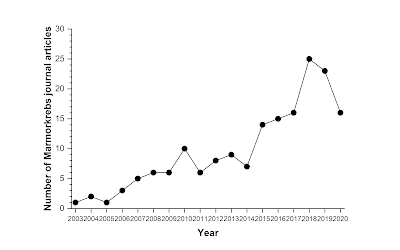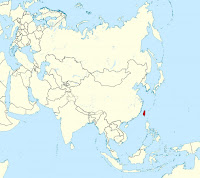While I was busy updating the marbled crayfish Wikipedia page with yesterday’s news that Marmorkrebs had been found in the waters of Belgium, I noticed another country on the list I hadn’t seen before.
Poland. Poland?
Yes. Last month, news reports came out about Marmorkrebs in Poland. And nobody told me! Presumably my automatic email alerts failed because I don’t have alerts for whatever the Polish word for “crayfish” is.
Not only are they in Poland, one article says that these may be amo ng the largest populations. The Polish lakes are estimated to have tens of thousands of individuals.
As usual, I have some fact-checking to do on the news report, since there is no scientific paper yet. Both articles say:
(T)he young produce eggs by themselves after about 2-3 months.
That’s much faster than the reproductive cycle in the literature. From hatching to first reproduction usually takes 7 months (Seitz et al 2005).
One article says:
The lack of males in this species makes it impossible to use pheromone methods or introduce genetically modified males as competition - the scientist explains.
Agree that genetically modified males wouldn’t work.
I’m not sure what “pheromones” is referring to. I don’t know off the top of my head of any attempt to use pheromones to control crayfish populations. But the lack of males may not be an obstacle, since Marmorkrebs still show sexual behaviour (Vogt et al. 2015). They might still respond to pheromones.
Predatory species of fish also cannot cope with it. Marbled crayfish kills catfish, pike, zander and perch.
This is a weird claim. I don’t know of any fish that has too much of a problem taking out crayfish. Marbled crayfish could kill fish when they’re small, maybe. But this makes it sound like Marmorkrebs are somehow invincible to these fish regardless of size.
The Epicrates Foundation has been doing quite a bit of work on this, working with a nearby national park to try to stem the Marmorkrebs from entering park waters.
Additional: Gregor Kalinkat mentions a 2018 survey in Poland found no Marmorkrebs.
External links
Epicrates Foundation (Facebook)
Raki mutanty już tu są. Niosą zagrożenie koło Włodawy i nie potrzebują do rozmnażania samców (Translation: “Crayfish mutants are already here. They pose a threat near Włodawa and do not need males to breed”)
W naszym regionie odkryto ogromną populację zmutowanych raków. Stanowią one ogromne zagrożenie dla ekosystemu (zdjęcia) (Translation: “A huge population of mutant crayfish has been discovered in our region. They pose a huge threat to the ecosystem (photos)”
Rak marmurkowy zagrożeniem dla Poleskiego Parku Narodowego (Translation: Marbled crayfish as a threat to the Poleski National Park)
References
Seitz R, Vilpoux K, Hopp U, Harzsch S, Maier G. 2005. Ontogeny of the Marmorkrebs (marbled crayfish): a parthenogenetic crayfish with unknown origin and phylogenetic position. Journal of Experimental Zoology A 303(5): 393-405. http://dx.doi.org/10.1002/jez.a.143
Vogt G, Falckenhayn C, Schrimpf A, Schmid K, Hanna K, Panteleit J, Helm M, Schulz R, Lyko F. 2015. The marbled crayfish as a paradigm for saltational speciation by autopolyploidy and parthenogenesis in animals. Biology Open 4(11): 1583-1594. http://dx.doi.org/10.1242/bio.014241






























